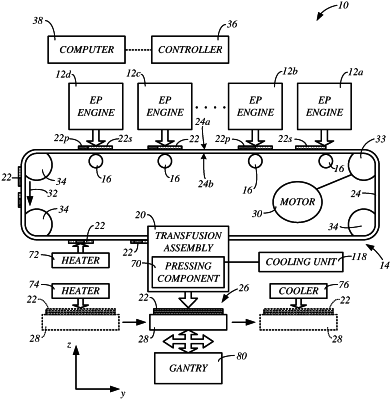| CPC B29C 64/147 (2017.08) [B33Y 10/00 (2014.12); G03G 15/224 (2013.01); B33Y 30/00 (2014.12)] | 18 Claims |

|
1. A method for printing a 3D part with a selective deposition based additive manufacturing system, the method comprising:
developing layers of a powder material using at least one electrostatographic engine;
transferring the developed layers from the at least one electrostatographic engine to a transfer medium;
heating a part build surface of the 3D part on the build platform to a temperature above a fusion temperature and within a range between a flowable temperature and a thermal oxidation threshold to form a flowable part build surface;
pressing one of the developed layers on the transfer medium into contact with the flowable part build surface to place the flowable part build surface into intimate contact with the one of the developed layers and thereby heating the one of the developed layers to a flowable state by conduction from the part build surface to form a new part build surface;
cooling the new part build surface to remove heat energy; and
repeating sequentially for each subsequent one of the developed layers the steps of heating the part build surface to form the flowable part build surface, pressing one of the developed layers on the transfer medium into contact with the flowable part build surface to form a new part build surface, and cooling the new part build surface to remove heat energy to form the 3D part in a layer-by-layer manner;
wherein heating the part build surface to the temperature to form the flowable part build surface occurs in a heat time τheat such that a thermal diffusion distance of heat added during the heating is less than four developed layer thicknesses.
|